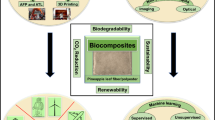Abstract
The mechanism of fracture and its removal for low-expansion glass ceramics processing was studied through grinding experiments. A dynamic coefficient K d was proposed to characterise the brittle material processing property. Using surface roughness as the evaluation index, the limitations of the empirical model and the brittle fracture model were analysed. On the basis of simple single-factor tests, two-step changes on the processing surface of brittle materials were observed for the first time, which could be described in terms of the critical depth of ductile and ductile–brittletransition (h c1) and the critical depth of ductile–brittle and brittle transition (h c2). The brittle material fracture processing and removal could be divided into three phases: ductile fracture, ductile–brittle fracture and brittle fracture. Furthermore, a compound grinding factor Q and a model of compound regime were proposed in this study, in order to comprehensively test the variation tendency of surface roughness and improve the model accuracy. A multi-factor cross-validation test also was conducted, and the results of the three models were compared with the test results. The model of compound regime (R a3) showed the highest precision.
Similar content being viewed by others
References
Tonshoff HK, Peters J, Inasaki I, Paul T (1992) Modelling and simulation of grinding processes. CIRP Ann Manuf Technol 41(2):677–688
Gopal AV, Rao PV (2003) The optimisation of the grinding of silicon carbide with diamond wheels using genetic algorithms. Int J Adv Manuf Technol 22(7–8):475–480
Huang H, Liu YC (2003) Experimental investigations of machining characteristics and removal mechanisms of advanced ceramics in high speed deep grinding. Int J Mach Tools Manuf 43(8):811–823
Nakayama K, Brecker J, Shaw MC (1971) Grinding wheel elasticity. J Eng Ind 93(2):609–613
Malkin S (1989) Grinding technology: theory and applications of machining with abrasives. Society of Manufacturing Engineers, Dearborn, Michigan
Annamalai VE, Sornakumar T, Gokularathnam CV, Krishnamurthy R (1993) Efficient grinding of Ce-TZP with SiC wheels. J Eur Ceram Soc 11(5):463–469
Tönshoff HK, Leirse T, Inasaki I (1999) Grinding of advanced ceramics. Machining ceramics C, 85-11F. Klocke, E. Verlemann, C. Schippers, high-speed grinding of ceramics. In: Jahanmir S, Ramulu M, Koshy P (eds) Machining of ceramics and composites. Marcel Dekker, New York, pp 119–138
Klocke F, Verlemann E, Schippers C (1999) High-speed grinding of ceramics. Manuf Eng Mater Proc 53:119–138
Hwang TW, Evans CJ, Whitenton EP, Malkin S (2000) High speed grinding of silicon nitride with electroplated diamond wheels, part 1: wear and wheel life. J Manufacturing Sci 122(1):32–41
Hwang TW, Evans CJ, Malkin S (2000) High speed grinding of silicon nitride with electroplated diamond wheels, part 2: wheel topography and grinding mechanisms. J Manufacturing Sci 122(1):42–50
Hu KX, Chandra A (1993) A fracture mechanics approach to modeling strength degradation in ceramic grinding processes. J Eng Ind 115(1):73–84
Chandra A, Huang Y, Wei X, Hu KX (1995) A hybrid micro–macro BEM formulation for micro–crack clusters in elastic components. Int J Numer Meth Eng 38(7):1215–1236
Chandra A, Hu KX, Huang Y (1995) A hybrid BEM formulation for multiple cracks in orthotropic elastic components. Comput Struct 56(5):785–797
Li YP, Tham LG, Wang YH, Tsui Y (2003) A modified Kachanov method for analysis of solids with multiple cracks. Eng Fract Mech 70(9):1115–1129
Reichenbach GS, Mayer JE, Kalpakcioglu S, Shaw MC (1956) The role of chip thickness in grinding. Trans Asme 18:847–850
Hecker RL, Liang SY, Wu XJ, Xia P, Jin DGW (2007) Grinding force and power modeling based on chip thickness analysis. Int J Adv Manuf Technol 33(5–6):449–459
Agarwal S, Rao PV (2012) Predictive modeling of undeformed chip thickness in ceramic grinding. Int J Mach Tools Manuf 56:59–68
Young HT, Liao HT, Huang HY (2007) Novel method to investigate the critical depth of cut of ground silicon wafer. J Mater Process Technol 182(1):157–162
Saini DP, Wager JG, Brown RH (1982) Practical significance of contact deflections in grinding. CIRP Ann Manuf Technol 31(1):215–219
Snoeys R, Peters J, Decneut A (1974) The significance of chip thickness in grinding. Ann CIRP 23(2):227–237
Ma LJ, Gong YD, Chen XH (2014) Study on surface roughness model and surface forming mechanism of ceramics in quick point grinding. Int J Mach Tools Manuf 77:82–92
Griffith AA (1921) The phenomena of rupture and flow in solids. Philosophical transactions of the royal society of London. Series A, Containing Papers of a Mathematical or Physical Character 221:163–198
Bifano TG, Dow TA, Scattergood RO (1991) Ductile-regime grinding: a new technology for machining brittle materials. J Eng Ind 113(2):184–189
Author information
Authors and Affiliations
Corresponding author
Rights and permissions
About this article
Cite this article
Ma, L., Yu, A., Gu, L. et al. Mechanism of compound fracture and removal in grinding process for low-expansion glass ceramics. Int J Adv Manuf Technol 91, 2303–2313 (2017). https://doi.org/10.1007/s00170-016-9915-3
Received:
Accepted:
Published:
Issue Date:
DOI: https://doi.org/10.1007/s00170-016-9915-3




